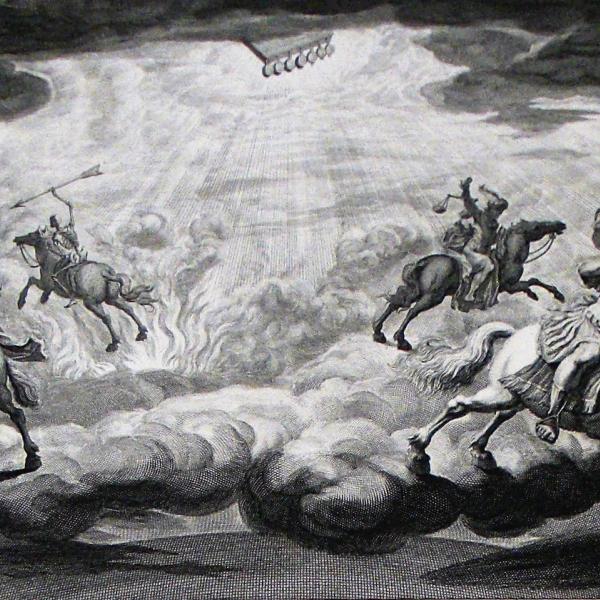The apostle Peter was a leader and role model in early Christianity - or was he? According to Lance Jenott, a lecturer of classics and religious studies, how we understand Peter depends on who is telling the story.

Transcript:
Kiva Runnels (host): Hi, I'm Kiva Runnels, a first-year student in Arts & Sciences here at WashU. I'm interested in storytelling in all its forms, and I'm kind of obsessed with podcasts and audio journalism. I've been working with Hold That Thought as an intern, and for my first Hold That Thought episode I sat down with Lance Jenott.
Lance Jenott (guest): I'm Lance Jenott, and I'm a lecturer in the Department of Classics and the program and religious studies at Washington University.
KR: I first heard about Jenott from two of my good friends who took his scriptures and cultureal traditions course during this past semester and would not shut up about how much they were learning from Lance Jenott. So I went to talk to him, and I found out that he studies many aspects of religious texts and Early Christianity - but one sacred text and one character stood out to him as having an important story to tell. Brought to you today by Hold That Thought and Lance Jenott, the story of the New Testament and the one and only Saint Peter.
LJ: The figure of Peter really interested me. I was studying the New Testament and Early Christian history, and Peter of course is known as really the leader of the Twelve Apostles. His real importance is because he becomes the foundation of clerical authority for the later history of the church, for the bishops and the entire Christian clergy.
KR: The apostles were Jesus' inner circle, his first twelve followers. The idea here is that thousands of years ago, the apostles, including Peter, passed down their authority to other early Christian leaders. Those leaders then passed down their authority to the next generation of leaders, and on and on until you get to today's bishops and priests.
LJ: Most church authorities, even today, whether it be Roman Catholic or the Eastern Orthodox churches or the Anglican Communion - every bishop can trace his or in some cases her authority all the way back to one of the Twelve Apostles.
KR: Scholars call this belief the doctrine of apostolic succession. The doctrine is especially important for Catholics. Why, you ask? Well, because of Peter. To this day, St. Peter's Basilica in Rome is one of the most important Catholic sites in the world.
LJ: The idea that the church in Rome is sort of the center, the main institution that the Roman Catholic Church holds onto, is grounded in the idea that eventually Peter made his way to Rome and he was basically a founder of the church in Rome.
KR: The significance of Peter within Catholicism and Christianity means that if you've read the Bible, taken a course in religious studies, or have been exposed to Catholicism and Christianity, you've probably heard of him. He's kind of a big deal, and not just for Catholics.
LJ: I think the general feeling is that he was a leader and really loyal, and maybe even a role model.
KR: But how do we know that Peter was a role model, or really anything about him? It turns out that almost everything we know about Peter comes from the New Testament, specifically the Gospels. But here's the thing about the gospels. There's four of them. And they don't all say the same thing.
LJ: That's where it gets even more interesting because we have four different gospels in the New Testament, and we know when you read the Gospels individually you actually see that there is some ambivalence about Peter's character.
When you read the Gospels individually, you actually see that there is some ambivalence about Peter's character.
KR: The four Gospels of the New Testament are attributed to four different writers: Matthew, Mark, Luke, and John. Three of these gospels - Matthew, Mark, and Luke - are referred to as the Synoptic Gospels. They're called synoptic because each of these three authors tells the same story. The big difference between the three is the way in which the story of Jesus and his disciples is told. And as we all know, the perspective of a storyteller can make all the difference. In the case of Peter, Mark's Gospel is quite a bit different from the rest.
LJ: It is the Gospel of Mark that is important here. Because if you can read Mark as Mark just on its own terms, and not read Mark through the stories as are told in the other Gospels, Matthew Luke and John, it's really in the Gospel of Mark where you see what for a lot of scholars has been a very critical and pessimistic representation of Peter.
KR: Critical? Pessimistic? These are not words that many associate with the head of the Catholic Church, a literal saint! But in the Gospel of Mark, that's what you get. To understand how Mark's version is so different from the other Gospels, we have to start at the beginning.
LJ: The whole story starts off very well. Peter shows great enthusiasm when Jesus calls him. Right in the very first chapter, Peter is called a follower of Jesus. But really from there on out in Mark's story, it all kind of goes downhill, especially for Peter.
KR: At the beginning of the Gospel of Mark, Peter is the very first disciple to be called by Jesus. Then he calls the other 11. But just because Jesus called these guys doesn't mean they were always the ideal followers.
LJ: Throughout Mark's Gospel, Jesus teaches a parable or teaches something to the disciples or he performs a miracle - and repeatedly, Mark says that the disciples failed to understand what Jesus was teaching. And this happens over and over again. Mark really highlights that they didn't understand, or their hearts were hardened. And so there is already in Mark a really critical representation of Jesus' inner circle.
KR: Wow, Mark was pretty brutal on the disciples here it seems. And just wait - it gets worse.
LJ: When you get to the middle of Mark's story, there's a famous scene that's actually three scenes. Scholars call it the triple prediction section, and that's because it's a place where Mark says right in the middle of his gospel, Jesus predicts that he's going to die three times to his disciples, and each time the disciples misunderstand. Mark follows this pattern where Jesus predicts his death, the disciples misunderstand, and then it provides an opportunity for Jesus to teach about discipleship. The message for Mark is that discipleship is really about suffering, and not about having glory and power. But each time the disciples didn't understand this either.
KR: Peter, who is the supposed leader of the disciples, also didn't understand. In fact, Peter, the person who is supposed to have the most faith in Jesus, not only doesn't believe him - he sort of yells at Jesus for saying he is going to suffer. For Peter, like for a lot of people, the idea that the son of God could suffer was really hard to believe. Mark knew that.
LJ: It's almost as if Mark is using the character of Peter to reflect what a lot of people thought in Mark's time, that the Messiah was going to be a powerful miracle worker, a great king that would drive the Roman Empire out of Judea and restore the the political kingdom of Israel. But Jesus comes along in Mark's gospel, and he says, actually the Messiah is about suffering, not about power. And so Peter even rebukes Jesus for this. And again, this is a classic moment in Mark's Gospel. It shows that the disciples didn't really understand who Jesus was and what he was all about.
It's almost as if Mark is using the character of Peter to reflect what a lot of people thought in Mark's time, that the Messiah was going to be a powerful miracle worker, a great king...
KR: OK, so had the Gospel of Mark ended here, it might have looked pretty bad for Peter and the boys. But wait - there's still more to the story!
LJ: From there it even gets worse.
KR: Oh man, I was hoping for a bit of redemption here! No such luck in the Gospel of Mark.
LJ: After Jesus has traveled around in the rural areas of Judea, they finally go to the city and they're going to keep the Passover meal. And at that last supper, which is the Passover meal, Jesus then again predicts that he's going to suffer. He actually predicts that all his disciples will abandon him. And Mark sets this whole story up very carefully, because at the supper, he says that Peter in particular said even if everybody else abandons you, I won't. But then immediately after dinner, they go out to the garden at Gethsemene to pray. And again Mark, the way he tells the story, really highlights that the disciples failed Jesus. Three times Jesus says, 'I'm going to go over here by myself to pray. And I want you to remain vigilant stay awake.' And then Jesus keeps coming back to them, and they keep falling asleep. They couldn't stay awake; they couldn't do what Jesus asked them to do. And of course Jesus knows what's coming. He knows the police are going to come with Judas Iscariot and arrest him. He keeps telling the disciples to stay awake, but they can't. So then the scene ends with Judas coming with the police, and they betray him. And then the very final line of that scene is, "and everybody fled." Just as Jesus said they would, they all took off. Which is actually the last time you hear about Jesus' 12 disciples in the Gospel of Mark.
KR: The last time you hear about the disciples. The disciples just sort of disappear from the story - that is, except for Peter.
LJ: So Mark actually brings Peter back for one more episode before the end of the Gospel. It may be that Mark is even playing with his readers a little bit, that if if you had never read Mark you might think, 'OK, well Peter is the leader of the disciples, maybe there's going to be some redemption for Peter.' Because in the story Mark says that they arrested Jesus, and then everybody fled. But Peter followed at a little bit of a distance. He was being cautious, and he followed Jesus to where they took him for his trial. But if the reader is thinking at this point that there may be some redemption for Peter, Mark ends up undercutting that, too. And it turns out actually this final episode, where Peter is included, really goes out of its way to make Peter look even worse than the others - because this is the final and famous story where Peter denies Jesus three times.
KR: At this point in the story Jesus is inside being interrogated. Outside, Peter is waiting in the courtyard.
LJ: People approach him, and they say, 'Weren't you one of his followers?" Three times he denies Jesus. Then the last thing you hear about Peter and the Gospel of Mark is he realized what he'd done, and he broke down and wept. And there's a little bit of ambivalence there, you know. It's not clear whether whether Mark was saying that Peter repented, but at any rate he did recognize what he had done and broke down in tears over it.
KR: Mark seems quite set on proving that discipleship is about suffering by showing all of Jesus' disciples betraying him, especially Peter. Mark's ending to his gospel, though, is one of the most glaring differences between his story and the versions in Luke and Matthew.
LJ: So then the gospel ends on a very curious note. Some women disciples go to Jesus' tomb, and they find of course, as the famous story goes, they find the tomb empty. There's a mysterious young man - Mark doesn't say it's an angel; it's just a mysterious young man - in the tomb. The young man tells the women, 'Go tell Peter and the other male disciples that Jesus has risen.' But then the way Mark ends the story, he says, 'But the women didn't tell anybody anything.' They ran away in fear. And that's it. So really, according to Mark's story, Jesus was risen but he he never met Peter and he never met his 12 disciples after the resurrection. So essentially, they all abandoned him, Peter denied him three times, and then the way Mark ends the story is that the disciples are more or less marginalized.
KR: A somebody who's not religious but went to Catholic school, I was actually unaware of Mark's choice to keep the disciples from reuniting with Jesus after the resurrection. In both Matthew and Luke, the story of Jesus ends with the reunion with his disciples and Jesus' famous decree that the apostles must travel the nations and spread his message. So why is this story and Mark so different from the one in Luke and Matthew?
LJ: One way to read this of course is that Mark represents one early Christian view from the first century within the first couple of generations of Christianity that had, at the very least, an ambivalent attitude toward the authority of the Twelve Apostles - and maybe even more than that, maybe even quite a critical view of them. It's very likely that Mark is written from a Christian viewpoint that that doesn't take the 12 disciples or somebody like Peter seriously.
KR: So the Gospel of Mark reflects an early Christian view of the disciples that is at the very least unflattering. This means that our modern understanding of the disciples as wise, devoted followers who spread the message of Jesus must come from the other two synoptics - Matthew and Luke.
LJ: Essentially the way Matthew and Luke write their gospels is what I like to call a rehabilitation of the twelve disciples. If you go through each of the stories where Mark says they misunderstood Jesus' teaching or they were hardhearted, in each case if you compare the version in Matthew and Luke and you look at the way Matthew and Luke rewrote Mark's story, they always change a little bit. They'll remove the part that said they misunderstood, or they'll remove the part that says they were hardhearted. Instead of misunderstanding, Matthew will say, "Then they praise Jesus and worshipped him." You know, it really makes them look like disciples who are are good role models, who do understand, who are faithful to Jesus.
Essentially the way Matthew and Luke write their gospels is what I like to call a rehabilitation of the twelve disciples.
KR: This softer, arguably more idealistic view of the disciples shows up most notably in the ways that Matthew and Luke end their gospels.
LJ: Instead of Mark's Gospel, where Jesus never meets the disciples after the resurrection, both in Matthew and Luke - in slightly different ways, but in both of them - Jesus appears to his disciples after the resurrection and transfers his authority to them and then sends them out to be apostles to the nations.
KR: So it seems like out of the two competing perspectives, those in Matthew and Luke have won most people over. But when it comes to stories, not only the person telling the story matters, but also the order in which they are presented.
LJ: Mark seems to be, or most scholars hold it to be, the first gospel. Which means Matthew and Luke were written later. Most scholars believe that Matthew and Luke had a copy of Mark and basically wrote their Gospels as an expansion, and in some ways a rewriting, of Mark. And what's fascinating is the order of the Gospels now is Matthew, then Mark, then Luke and John. It's actually as if Mark had been bookended by Matthew and Luke so that that Mark is read in terms of Matthew and Luke, so that the reader knows that Jesus appeared to his apostles.
KR: Had the Gospels been ordered chronologically, with Mark first, we might get a different view of Peter and the other Apostles. Matthew and Luke would look like a rewrite. But the early church didn't want our first impression of the disciples to be so negative.
LJ: In the history of religions, traditions get read in terms of one another, and oftentimes traditions are being read for very concrete, even political, reasons. In this case, taking the case of Peter and the institution of the Twelve Apostles to legitimate what becomes the institution of the clergy and the bishopric and the doctrine of apostolic succession. So when you have a tradition like the one in Mark that could possibly threaten that or call it into question, then that has to be interpreted in terms of some other traditions.
KR: Learning how to read each gospel individually can help personalize a religious experience and help us see a diversity of views expressed in a sacred text. Even if the institution of the religion seems to have a singular point of view or interpretation, rhe original text might say something different. If you've never thought about these issues or about St. Peter as a controversial figure, you're hardly alone. Jenott himself hasn't always understood the ways that the Bible tells different stories.
LJ: I was raised in a very Christian fundamentalist home, where there's sort of one story that the Bible represents. So learning to read the Gospels as individual texts not only gives me a better idea about the diversity of views among early Christians - I came to understand that the Gospels don't all tell the same story, right? There are four gospels, which means in some way there's going to be at least four different stories. Not necessarily in a critical way either. It's given me an appreciation for understanding that each evangelist has his own message and his own emphasis, and it makes the stories about Jesus much more rich when you can really see what it is that each four of the gospel writers is trying to say about Jesus and how they're doing that differently. So it really enriches the traditions about Jesus for me.
There are four gospels, which means in some way there's going to be at least four different stories.
Claire Navarro (producer): A huge thank you to Lance Jenott for joining Hold That Thought, and to Kiva Runnels for being our very first intern guest producer. For our full archive of episodes, please check us out on Facebook, Twitter, or at Holdthatthought.wustl.edu. Thank you for listening.





